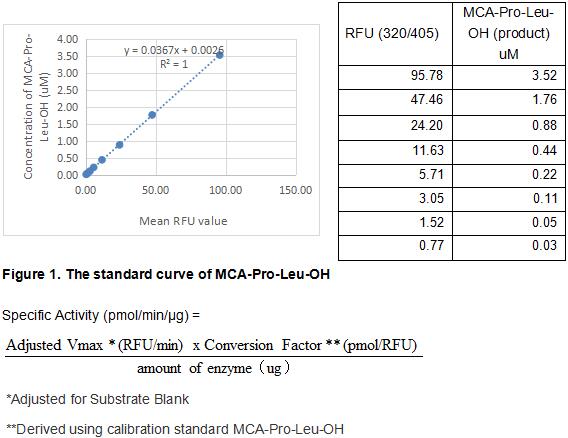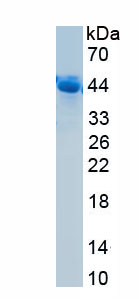Active Cathepsin D (CTSD) 

CPSD; CLN10; Lysosomal Aspartyl Protease; Ceroid-Lipofuscinosis,Neuronal 10
- UOM
- FOB US$ 338.00 US$ 845.00 US$ 1,690.00 US$ 5,070.00 US$ 12,675.00
- Quantity
Overview
Properties
- Product No.APB280Hu62
- Organism SpeciesHomo sapiens (Human) Same name, Different species.
- ApplicationsCell culture; Activity Assays.
Research use only - DownloadInstruction Manual
- CategoryTumor immunity
- Buffer FormulationPBS, pH7.4, containing 5% Trehalose.
- Traits Freeze-dried powder, Purity > 90%
- Isoelectric Point6.5
Sign into your account
Share a new citation as an author
Upload your experimental result
Review

Contact us
Please fill in the blank.
Activity test

Cathepsin D is a lysosomal aspartic protease of the pepsin family. Human cathepsin D is synthesized as a precursor protein, consisting of a signal peptide (residues 1 18), a propeptide (residues 19 64), and a mature chain (residues 65 412). The mature chain can be processed further to the light (residues 65 161) and heavy (residues 169 412) chains. It is expressed in most cells and overexpressed in breast cancer cells. It is a major enzyme in protein degradation in lysosomes, and also involved in the presentation of antigenic peptides. Mice deficient in this enzyme showed a progressive atrophy of the intestinal mucosa, a massive destruction of lymphoid organs, and a profound neuronal ceroid lipofucinosis, indicating that cathepsin D is essential for proteolysis of proteins regulating cell growth and tissue homeostasis. The activity of recombinant human CTSD is measured by its ability to cleave a fluorogenic peptide substrate MCA-Pro-Leu-Gly-Leu-DPA-Ala-Arg-NH2 in the assay buffer 0.1 M NaOAc, 0.2 M NaCl, pH 3.5. The rhCTSD is diluted to 20 ug/ml in assay buffer, then incubated at 37 °C for 30min. The incubated rhCTSD is diluted to 5 ug/mL in assay buffer. Loading into a black well plate 50 µL of 5 ug/mL rhCTSD and start the reaction by adding 50 µL of 60 µM substrate, with a substrate blank containing 50 µL assay buffer, 50 µL substrate, and no rhCTSD. Then read at excitiation and emission wavelengths of 320 nm and 405 nm, respectively, in kinetic mode for 5 minutes. The specific activity of recombinant human CTSD is > 675 pmol/min/µg.
Usage
Reconstitute in 10mM PBS (pH7.4) to a concentration of 0.1-1.0 mg/mL. Do not vortex.
Storage
Avoid repeated freeze/thaw cycles. Store at 2-8°C for one month. Aliquot and store at -80°C for 12 months.
Stability
The thermal stability is described by the loss rate. The loss rate was determined by accelerated thermal degradation test, that is, incubate the protein at 37°C for 48h, and no obvious degradation and precipitation were observed. The loss rate is less than 5% within the expiration date under appropriate storage condition.
Increment services
-
 BCA Protein Quantification Kit
BCA Protein Quantification Kit
-
 Molecular Mass Marker for Protein
Molecular Mass Marker for Protein
-
 Monoclonal Antibody Customized Service
Monoclonal Antibody Customized Service
-
 Polyclonal Antibody Customized Service
Polyclonal Antibody Customized Service
-
 Protein Activity Test Experiment Service
Protein Activity Test Experiment Service
-
 Electrophoretic Mobility Shift Assay (EMSA) Experiment Service
Electrophoretic Mobility Shift Assay (EMSA) Experiment Service
-
 Buffer
Buffer
-
 Lentivirus Packaging Experiment Service
Lentivirus Packaging Experiment Service
-
 Adenovirus Packaging Experiment Service
Adenovirus Packaging Experiment Service
-
 Real Time PCR Experimental Service
Real Time PCR Experimental Service
-
 Spike RBD Protein (S-RBD)
Spike RBD Protein (S-RBD)
-
 Protein G
Protein G
-
 Protein A
Protein A
Citations
- Cathepsin D is released after severe tissue trauma in vivo and is capable of generating C5a in vitroScienceDirect: S0161589011008297
- Plasma Cathepsin D Levels: A Novel Tool to Predict Pediatric Hepatic InflammationPubMed: 25732418
- Plasma cathepsin D correlates with histological classifications of fatty liver disease in adults and responds to interventionpubmed:27922112
- Berberine ameliorates intrahippocampal kainate-induced status epilepticus and consequent epileptogenic process in the rat: Underlying mechanismspubmed:28061403
- Limited applicability of cathepsin D for the diagnosis and monitoring of non‐alcoholic steatohepatitis
- Plasma cathepsin D activity is negatively associated with hepatic insulin sensitivity in overweight and obese humansPubmed: 31690989
- Iron and Advanced Glycation End Products: Emerging Role of Iron in Androgen Deficiency in ObesityPubmed: 32235809
- LVV-hemorphin-7 (LVV-H7) plays a role in antinociception in a rat model of alcohol-induced pain disorders33253777
- Identification of Cathepsin D as a Plasma Biomarker for Alzheimer's Disease33445607
- Analysis of silymarin-modulating effects against acrylamide-induced cerebellar damage in male rats: Biochemical and pathological markers33965515
- PGRS Domain of Rv0297 of Mycobacterium tuberculosis Is Involved in Modulation of Macrophage Functions to Favor Bacterial Persistence33042856
- Serum CathepsinD in pregnancy: relation with metabolic and inflammatory markers and effects of fish oils and probioticsPubmed:35304048
- A Comparison of Various Chips Used for the Manufacture of Biosensors Applied in Non-Fluidic Array SPRi, Based on the Example of Determination of Cathepsin DPubmed:35049649







